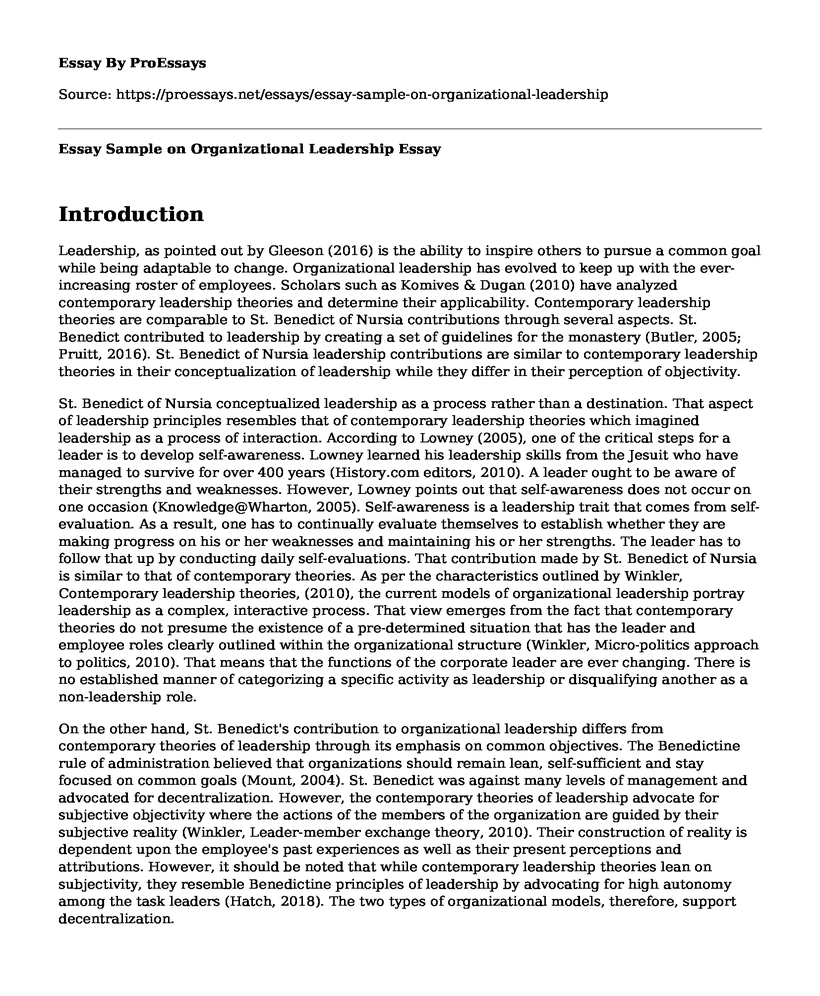Introduction
Leadership, as pointed out by Gleeson (2016) is the ability to inspire others to pursue a common goal while being adaptable to change. Organizational leadership has evolved to keep up with the ever-increasing roster of employees. Scholars such as Komives & Dugan (2010) have analyzed contemporary leadership theories and determine their applicability. Contemporary leadership theories are comparable to St. Benedict of Nursia contributions through several aspects. St. Benedict contributed to leadership by creating a set of guidelines for the monastery (Butler, 2005; Pruitt, 2016). St. Benedict of Nursia leadership contributions are similar to contemporary leadership theories in their conceptualization of leadership while they differ in their perception of objectivity.
St. Benedict of Nursia conceptualized leadership as a process rather than a destination. That aspect of leadership principles resembles that of contemporary leadership theories which imagined leadership as a process of interaction. According to Lowney (2005), one of the critical steps for a leader is to develop self-awareness. Lowney learned his leadership skills from the Jesuit who have managed to survive for over 400 years (History.com editors, 2010). A leader ought to be aware of their strengths and weaknesses. However, Lowney points out that self-awareness does not occur on one occasion (Knowledge@Wharton, 2005). Self-awareness is a leadership trait that comes from self-evaluation. As a result, one has to continually evaluate themselves to establish whether they are making progress on his or her weaknesses and maintaining his or her strengths. The leader has to follow that up by conducting daily self-evaluations. That contribution made by St. Benedict of Nursia is similar to that of contemporary theories. As per the characteristics outlined by Winkler, Contemporary leadership theories, (2010), the current models of organizational leadership portray leadership as a complex, interactive process. That view emerges from the fact that contemporary theories do not presume the existence of a pre-determined situation that has the leader and employee roles clearly outlined within the organizational structure (Winkler, Micro-politics approach to politics, 2010). That means that the functions of the corporate leader are ever changing. There is no established manner of categorizing a specific activity as leadership or disqualifying another as a non-leadership role.
On the other hand, St. Benedict's contribution to organizational leadership differs from contemporary theories of leadership through its emphasis on common objectives. The Benedictine rule of administration believed that organizations should remain lean, self-sufficient and stay focused on common goals (Mount, 2004). St. Benedict was against many levels of management and advocated for decentralization. However, the contemporary theories of leadership advocate for subjective objectivity where the actions of the members of the organization are guided by their subjective reality (Winkler, Leader-member exchange theory, 2010). Their construction of reality is dependent upon the employee's past experiences as well as their present perceptions and attributions. However, it should be noted that while contemporary leadership theories lean on subjectivity, they resemble Benedictine principles of leadership by advocating for high autonomy among the task leaders (Hatch, 2018). The two types of organizational models, therefore, support decentralization.
It is worth noting that while the Benedictine principle of leadership has variations to contemporary leadership techniques, the two models have more similarities than differences. Benedictine leadership principles recognize the importance of innovation and adaptability just like the modern models (Winkler, Attribution theory in leadership research, 2010). Additionally, both models advocate for a value-based approach to leadership (lumen, n.d.). Nevertheless, the most standout feature that represents the similarity between Benedictine leadership and contemporary models is the rule of group reliance and mutual respect. According to St. Benedict, good leadership involves building a cohesive working team where mutual respect is accorded to all members of the organization regardless of their title (St. Benedict and his Rules, 2008).
References
Butler, C. (2005). Benedictine Monachism: Studies in Benedictine life and rule. Wipf & Stock Publishers.
Gleeson, B. (2016, November 09). 10 unique perspectives on what makes a great leader. Retrieved from Forbes: https://www.forbes.com/sites/brentgleeson/2016/11/09/10-unique-perspectives-on-what-makes-a-great-leader/#16c2cb8d5dd1
Hatch, M. J. (2018). Organizational theory: Modern, symbolic, and postmodern perspectives. Oxford university press.
History.com editors. (2010, July 21). Jesuit order established. Retrieved from History: https://www.history.com/this-day-in-history/jesuit-order-established
Knowledge@Wharton. (2005, June 1). The secrets of Jesuit leadership. Retrieved from Wharton University of Pennsylvania: http://knowledge.wharton.upenn.edu/article/the-secrets-of-jesuit-leadership/
Komives, S., & Dugan, J. (2010). Contemporary leadership theories. In R. Cuoto (Ed.), Political and Civic Leadership (Vol. 1, pp. 111-120). California: SAGE Publications. doi:10.4135/9781412979337.n14.
Lowney, C. (2005). Heroic Leadership: Best Practices from a 450-Year-Old Company That Changed the World. Chicago: Loyola Press.
Lumen. (n.d.). Contemporary approaches to leadership. Retrieved from Lumen: https://courses.lumenlearning.com/principlesmanagement/chapter/10-5-contemporary-approaches-to-leadership/
Mount, J. (2004, November 09). Business the Benedictine way. Retrieved from Forbes: https://www.forbes.com/2004/11/09/1109bookreview.html#22ba7af74d52
Pruitt, S. (2016, May 31). 6 reasons the dark ages weren't so dark. Retrieved from History: https://www.history.com/news/6-reasons-the-dark-ages-werent-so-dark
St. Benedict and his Rules. (2008, February 25). St. Benedict and His Rules. Retrieved from St. Benedict and His Rules: http://stbenedictandhisrules.blogspot.com/2008/02/benedictine-way-of-leadership.html
Winkler, I. (2010). Contemporary leadership theories. New York: Physica-Verlag.
Winkler, I. (2010). Attribution theory in leadership research. In Contemporary Leadership Theories (pp. 9-22). Physica-Verlag HD.
Winkler, I. (2010). Leader-member exchange theory. In Contemporary Leadership Theory (pp. 47-53). Physica-Verlag HD.
Winkler, I. (2010). Micro-politics approach to politics. In Contemporary Leadership Theories (pp. 65-74). Physica-Verlag HD.
Cite this page
Essay Sample on Organizational Leadership. (2022, Nov 23). Retrieved from https://proessays.net/essays/essay-sample-on-organizational-leadership
If you are the original author of this essay and no longer wish to have it published on the ProEssays website, please click below to request its removal:
- The Role of Transformational Leadership in Amazon's Success and Achievements
- Fallacies of Relevance in Ford-Firestone Paper Example
- Essay Sample on Leadership and Management Behaviors
- Maximizing Growth: Analyzing Internal & External Environments at Kelly Services
- Netflix: A People-Oriented Culture for Global Expansion - Essay Sample
- Pursuing an MBA/MS: Exploring My Future Career - Essay Sample
- Essay Example on Northwell Health: Leaders Advancing Excellence & Compassion







